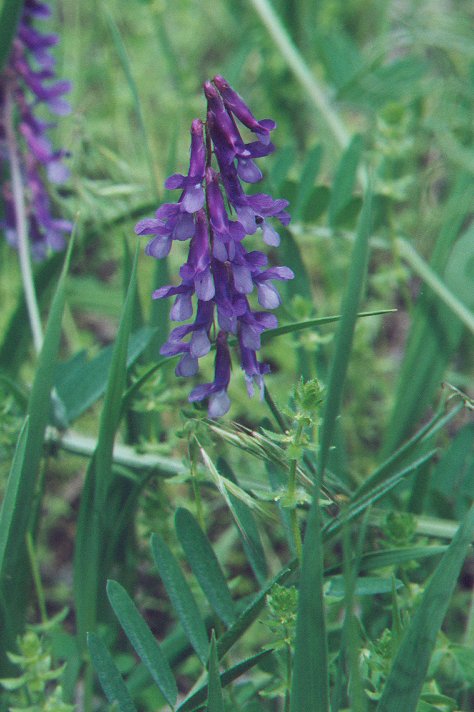Vicia villosa Roth
Woolly Vetch

Introduced
CC = *
CW = 5
MOC = 47
© DETenaglia
Vicia villosa RothWoolly Vetch | |
 |
Introduced CC = * CW = 5 MOC = 47 |
© DETenaglia |
|
Family - Fabaceae/Faboideae Stems - Sprawling to clambering or climbing (by means of tendrils on leaves), herbaceous, from taproot, villous, carinate to angled. Leaves - Alternate, even-pinnate, stipulate, to +13cm long, with +/-10 pairs of leaflets, terminating with a branched tendril. Stipules foliaceous, lance-ovate, to +/-1cm long, villous. Leaflets alternate to subopposite, on short petiolules, linear-oblong to linear-lanceolate, mucronate, entire, to +2cm long, +/-6mm broad, dense pubescent.
Inflorescence - Pedunculate spikiform axillary raceme to +/-7cm long. Peduncle to +/-6cm long, carinate, villous. Pedicels to 2mm long, connected to lower portion of calyx tube. Flowers nodding and secund.
Flowers - Corolla blue-purple, papilionaceous, glabrous. Standard to 1.3cm long, 7mm broad at apex, notched. Wing petals adhering to keel petals. Stamens 10, diadelphous, to 1cm long, glabrous. Style upcurved, pubescent at apex. Ovary compressed, green, glabrous, 6-7mm long, on short gynophore. Calyx tube to 3mm long, villous below(sparse above), bilabiate. Upper lip reduced, with two shallow lobes. Lobes to 1mm long, acuminate. Lower lip 3-lobed. Lateral two lobes to 4mm long, -1mm broad. Central lobe to 6mm long, -1mm broad, villous. Fruit compressed, to 3cm long, 1cm broad, pubescent, few seeded.
Flowering - April - October. Habitat - Waste ground, disturbed sites, roadsides, railroads. Origin - Native to Europe. Other info. - This species is an aggressive weed in Missouri. Although the flowers are striking, it should not be willingly spread. Plants with the typical blue-purple flowers are V. villosa f. villosa. Another form of the plant, V. villosa f. albiflora (Schur) Gams. was recently found in the state. This form has pure white flowers and can be found in the "White Flowers Alternate" section of this website. Photographs taken at the Honey Creek Conservation Area, Andrew County, MO., 5-3-00. |